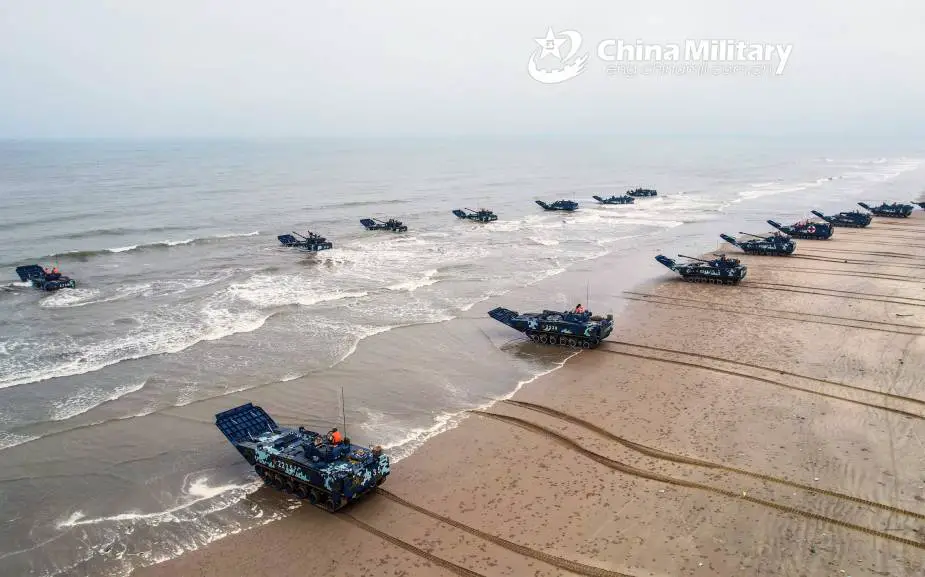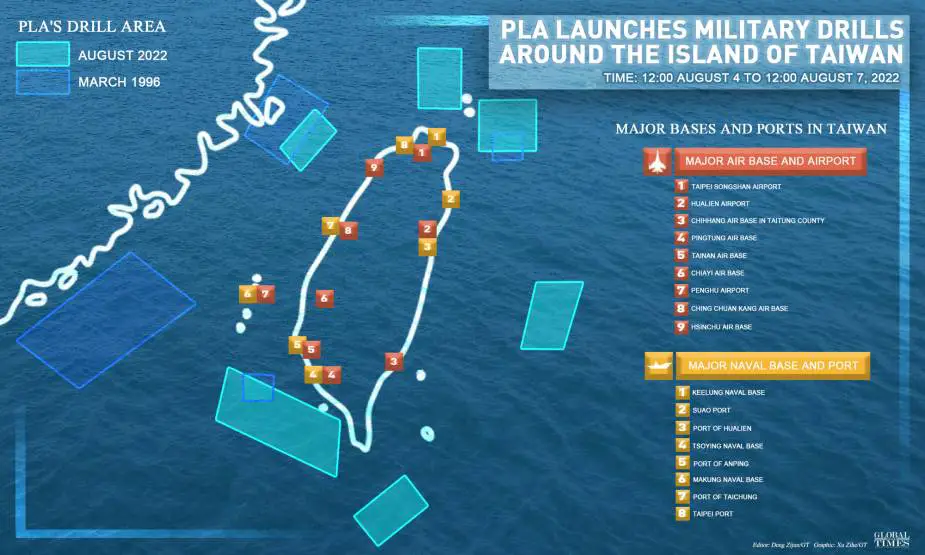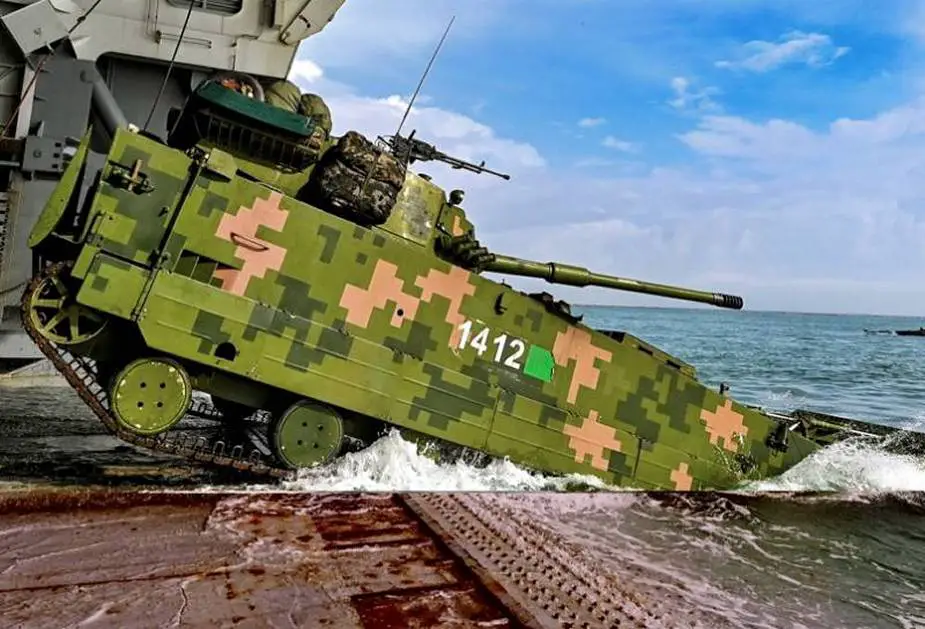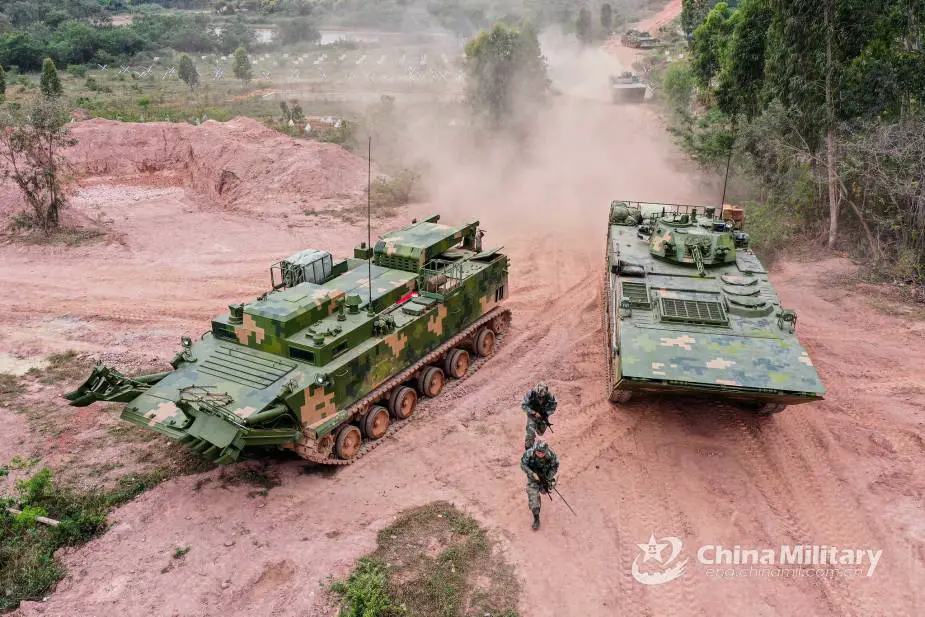Analysis: What are amphibious capabilities of China armed forces in case of Taiwan invasion
US House Speaker Nancy Pelosi’s recent visit to Taiwan triggered Beijing’s anger, which takes the form of unprecedented military exercises around and even partly inside Taiwan's naval waters and air space. Let us focus on the amphibious capabilities of the People’s Liberation Army to actually take part in an invasion of Taiwan.
Follow Army Recognition on Google News at this link

ZTD-05 and ZBD-05 amphibious armored vehicles of the PLA Marine Corps in a training exercise on March 13, 2022 (Picture source: eng.chinamil.com.cn - Li Weike)
According to the China Military Power report issued in 2019 by the Defense Intelligence Agency, China’s anticipation that foreign forces would intervene in a Taiwan scenario led the People’s Liberation Army (PLA) to develop a range of systems to deter and deny foreign regional force projection. The implementation of former president Hu Jintao’s New Historic Missions in 2004 led to the incremental expansion of the military’s modernization priorities to develop a PLA capable of operating in new domains and at increasing distances from the mainland.
During this modernization process, the report explains, PLA ground, air, naval, and missile forces have become increasingly able to project power during peacetime and in the event of regional conflicts. Beijing almost certainly will use this growing ability to project power to bolster international perceptions of its role as a regional power and global stakeholder. Although Beijing states that its intent is to serve as a stabilizing force regionally, in practice the PLA’s actions frequently result in increased tensions. Since 2012, Beijing has routinely challenged Tokyo’s Senkaku Island claims in the East China Sea. China’s Coast Guard frequently conducts incursions into the contiguous zone surrounding the islands to further China’s claims, while its Navy operates around the claims to enforce administration. The PLA has expanded and militarized China’s outposts in the South China Sea, and China’s Coast Guard, backed by the PLAN, commonly harasses Philippine and Vietnamese ships in the region.
Examples of incremental improvements to PLA power projection in the region are readily found in annual military exercises and operations. For instance, in 2015 the PLA Air Force (PLAAF) carried out four exercise training missions past the first island chain through the Bashi Channel, the northernmost passage of the Luzon Strait, and through the Miyako Strait closer to Japan. The Miyako Strait flights were 1,500 kilometers from Guam, within range of the PLAAF’s CJ-20 air-launched land-attack cruise missile (LACM). Also in 2015, the PLAAF began flying the H-6K medium-range bomber, the PLAAF’s first aircraft capable of conducting strikes on the U.S. island of Guam (with air-launched LACMs like the CJ-20), past the first island chain into the western Pacific.
China is also developing new capabilities that enhance Beijing’s ability to project power. In September 2016, then-PLAAF Commander Gen. Ma Xiaotian confirmed for the first time that the LAAF was developing a new long-range bomber that would undoubtedly exceed the range and capabilities of the H-6K. Although the H-6K began flying with LACMs, this Chinese-built airframe is the
10th design variant of the Soviet Tu-16, which began flying in 1952. In 2016, China and Ukraine agreed to restart production of the world’s largest transport aircraft, the An-225, which is capable of carrying a world-record payload of nearly 254 tons. China expected the first An-225 to be delivered and operational by 2019, which didn’t actually happen. If used by the military, such a capability would facilitate the PLA’s global reach. The last An-225 was destroyed at the beginning of the Russian invasion of Ukraine started on February 24, 2022.
In addition to land-based aircraft, China is currently increasing its fleet of domestically designed and produced aircraft carriers. Beijing is assumed to use the carrier to project power throughout the South China Sea and possibly into the Indian Ocean.
Taiwan will be reunited with mainland China, by force if necessary, said Xi Jinping
Power Projection and Expeditionary Operations Beijing’s longstanding interest to eventually compel Taiwan’s reunification with the mainland and deter any attempt by Taiwan to declare independence has served as the primary driver for China’s military modernization.
Large-scale amphibious invasion is one of the most complicated and difficult military operations to plan and implement, requiring air and maritime superiority, the rapid buildup and sustainment of supplies onshore, and uninterrupted support. An attempt to invade Taiwan would likely strain China’s armed forces and trigger international intervention. These stresses, combined with PLA’s combat force attrition and the complexity of urban warfare and counterinsurgency, even assuming a successful landing and breakout, make an amphibious invasion of Taiwan a significant political and military risk for Xi Jinping and the Chinese Communist Party.
The PLA is capable of attempting various amphibious operations short of a full-scale invasion of Taiwan. With few overt military preparations beyond routine training, the PRC could launch an invasion of small Taiwan-occupied islands in the South China Sea such as Pratas or Itu Aba. A PLA invasion of a medium-sized, better-defended island such as Matsu or Jinmen is within the PLA’s capabilities. Such an invasion would demonstrate military capability, political resolve, and achieve tangible territorial gain while simultaneously showing some measure of restraint. However, this kind of operation involves significant, and possibly prohibitive, political risk because it could galvanize pro-independence sentiment on Taiwan and generate powerful international opposition. The unprecedented multidomain exercice started by the Chinese forces around and partly above Taiwan’s territory on August 3 will give the answer.

PLA launches military drills around the island of Taiwan (Graphic: Xu Zihe/GT)
PLA’s Marine amphibious vehicles involved
A video going viral on social media shows tanks on the beaches of Xiamen city, which lies just across the strait from Taiwan. The video posted on Reddit shows beachgoers surrounded by a row of tanks that are moving ahead. A resident of Xiamen told South China Morning Post (SCMP) that he had seen a few dozen military vehicles of various types roll into the city and head towards its main ring road since Sunday, August 31. Chen Jinhuo, the owner of a restaurant, added that "about a hundred" armored vehicles are parked on the main ring road, NDTV reports.The Type 05 amphibious armored vehicle is a family of amphibious tracked armored fighting vehicles developed in the early 2000s by Norinco, led by chief designer Chen Pengfei, for the People's Liberation Army Navy Marine Corps. Two variants of the vehicle family was developed first, the infantry fighting variant ZBD-05, and assault gun/light tank variant ZTD-05. ZBD-05 vehicles were showcased in military parades of 2009 and 2015.
The Type 05 amphibious infantry fighting vehicle uses a planing hull propelled by two water jets, which is a considerable improvement over a similar type of vehicle like the AAV7A1 amphibious assault vehicle (AAV).

ZTD-05 attached to a brigade under the 73th Group Army leaving a landing ship, May 26, 2021 (Picture source: eng.chinamil.com.cn - Lin Jiayu)
The ZTD-05 assault vehicle variant replaces the obsolete Type 63A amphibious tank introduced in the late 1990s. Research and development effort is reflected on the capable design. The vehicle implicates China is determined to secure advanced amphibious assault capabilities
Mobility
The Type 05 features a flat hull, extendable bow, with six retractable road wheels on each side and front/rear rollers. The vehicle's design results in significantly reduced drag. The angle of the bow changes adaptively according to the current displacement speedometer so that fluid resistance can always be kept at the lowest, optimal level.
The ZBD-05 is fully amphibious and propelled by two large water jets mounted to the rear side of the hull. In the water, the engine is able to generate 1,475 horsepower as well as switch to land mode with only 550 horsepower. The vehicle can run at a maximum road speed of 65 km/h and 30 km/h in the water. It has a maximum cruising range of 500 km and can negotiate a gradient of 60 % and a side slope of 30%. It can cross a vertical obstacle of 0.7 m and a trench of 2m.
Armament
ZTD-05 assaults vehicle armed with 105mm rifled gun seen at Joint Sea-2016 military exercises
The Infantry Fighting Vehicle (IFV) variant, ZBD-05, is built to support infantry and amphibious operations. The 3-man crew consists of the driver positioned front-left of the turret, with the commander and gunner occupying the turret. The vehicle features Za PT-99 30mm cannon turret with an HJ-73C ATGM rail launcher, capable of penetrating more than 800mm RHA after ERA. The vehicle can carry 7 to 8 (one squad) armed infantry in its passenger compartment at the rear.
The Assault Vehicle (light tank) variant, ZTD-05, is armed with a fully stabilized ZPL-98A 105mm rifled gun.[8] The ZTD-05 assault vehicle variant has a crew of four, including a loader.[9] The type of APFSDS round fitted on ZTD-05 is the DTC02-105 armor piercing fin stabilized discarding sabot based on BTA-2 105mm APFSDS, capable of penetrating 600mm RHA at 2,000 meters. The rifled gun is also capable of launching laser-guided beam-riding missiles. The gun is loaded manually with a fire rate of 6 to 8 rounds per minute with 36 rounds of ammo reserve. ZTD-05's turret shares a similar layout to the ZTL-11 assault vehicle. Secondary weapons for both variants include a Type 86 7.62mm coaxially mounted machine gun. ZTD-15 features a QJC-88 12.7mm anti-aircraft machine gun mounted on the roof of the turret near the loader.
Fire control
Accuracy and precision are attained by a computerized fire-control system (FCS) on both ZBD-05 and ZTD-05. The fire control system includes a fire-control ballistic computer, laser rangefinder, two-plane stabilization, and daylight/infrared gunner sight with a passive night vision channel. Commander has access to day/night independent thermal sight with hunter-killer (commander override) capability.
Type 05 is fitted with a battle management system, command and control system, and digital map interface. All the necessary information is displayed on screens to the driver, commander, and gunner. ZTD-05 is equipped with a laser designator for beam-riding SACLOS applications, and the loader position is also fitted with an independent periscope.
Protection
The vehicle has satellite navigation, fire suppression system, NBC protection system, day/night thermal vision, ensuring a high degree of survivability for the crew. The hull is constructed with aluminum alloy chassis with additional steel glacis plates. Aluminum alloy reduces weight and provides protection against small arms rounds and shell splatter, while the steel plates can stop 12.7mm rounds. The turret is constructed of all-welded steel armor with composite plates, which gives all-around protection against 12.7mm rounds and shell splinters. The front face of the turret is claimed to stop 25mm AP round at 1,000 meters (3,300 ft). The upper part of the suspension is protected by armor plates.
Both ZBD-05 and ZTD-05 are fitted with laser warning receivers, which are connected to 2 sets of 4-barrel smoke grenade launchers. The storage area around the aft section double as slat armor.

ZBD-05 of PLA 73rd Group Army embarking in landing ship, 9-8-2021 (Picture source: eng.chinamil.com.cn - Xu Mingzhang)
Variants
* Type 05 (ZTD-05 or ZLT-05) Amphibious Assault Vehicle
The assault gun variant is armed with a ZPL98A 105mm low-recoil rifled gun, a 7.62mm coaxial machine gun, and a QJC-88 12.7mm anti-aircraft machine gun. An improved variant, designated ZLT-05A, with an upgraded computer system and digital terminals accessible for the driver, gunner, and commander.
* Type 05 (ZBD-05) Amphibious Infantry Fighting Vehicle
The infantry fighting vehicle variant is armed with a ZPT-99 30mm autocannon, a 7.62mm coaxial machine gun, and * HJ-73C anti-tank missiles.
* Type 05 (ZSD-05) Amphibious Armored Personal Carrier
The armored personal carrier variant is armed with a plate-protected 12.7mm heavy machine gun turret.
* Type 05 Amphibious Armored Reconnaissance Vehicle
The Armoured reconnaissance variant is equipped with a telescopic mast with an electro-optical and infrared (EO/IR) system, a laser range finder, and an X-band radar. The variant has a 12.7 mm heavy machine gun turret for defense.
* Type 05 Amphibious Armored Command Vehicle
The mobile command and control variant is equipped with a field communication and battle management system.
* Type 05 Amphibious Armored Recovery Vehicle
The armored recovery vehicle variant is equipped with a crane and a hydraulic winch for emergency vehicle recovery. An additional handrail is installed on the top for ease of operation in the water.
* Type 05 Assault Breach Vehicle
The mine clearance assaults vehicle variants. It is equipped with a mine plow, mine detection device, and rocket-projected mine-clearing line charge (MICLIC).
* Type 05 Amphibious Armored Ambulance
Armored ambulance variant based on Type 05 command vehicle chassis, providing frontline medical support and evacuation. The armored ambulance features an emergency ventilator, air conditioning, monitoring, and shock-absorbing double bunk beds.
* VN16
Modified export variants of the ZTD-05.
* VN18
Modified export variants of the ZBD-05.
* VS25
Modified export variants of the Type 05 Amphibious Armored Recovery Vehicle

Left: Type 05 Assault Breach Vehicle. Right: ZBD-05 (Picture source: eng.chinamil.com.cn - Xu Mingzhang)


























